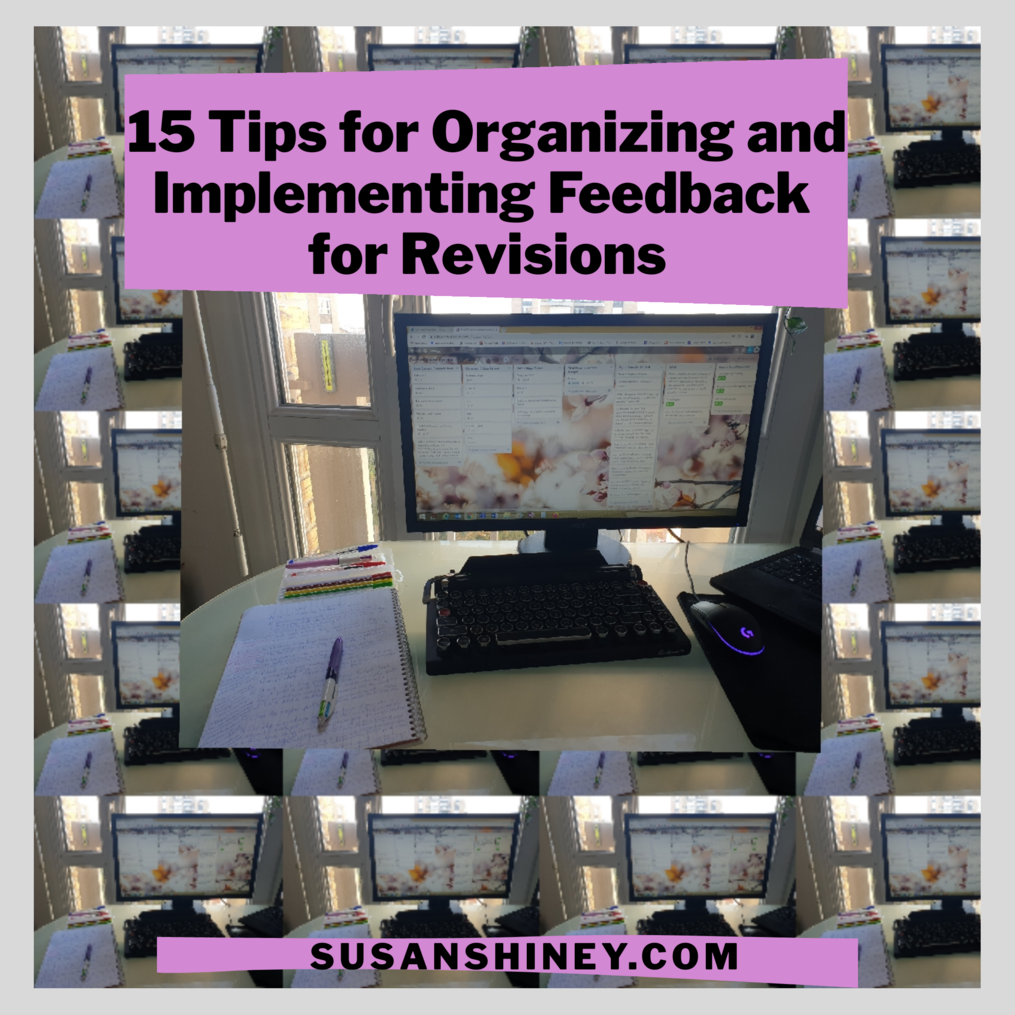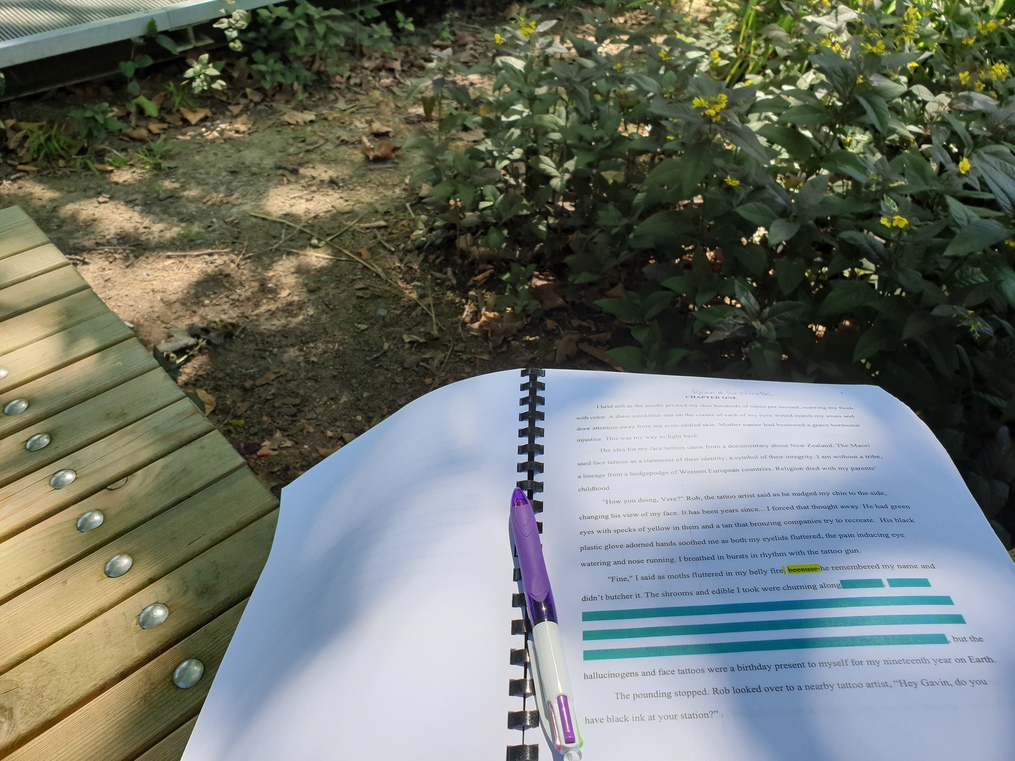
Critique partner and beta reader feedback is a very important part of the writing process. However, it can be overwhelming.
The first step is getting over the fact that deep down you expect them to say it was a masterpiece and even though they tried so hard, they could not find a single thing they would change. You have to look at it with a deep seated desire to improve your writing piece and not get pats on the back.
For advice on how to start a critique circle you can read N.M. Browne's article. I also have a blog post about studying craft books with your critique partners.
It is also challenging wrangling with your ego because when you give them your manuscript it was probably at the point where you couldn't find anything else to fix. Yes, that means dealing with the sting of unearthing all your blind spots.
It seems simple, but I think this is what keeps a lot of people from pursuing their creative dreams : the critique process. I have had several people say they couldn't handle it. Yeah, it's rough. To get away from writing block paralysis, I have been thinking a lot about how to have a structure to dealing with feedback to get me in gear for the next couple drafts of my novel. I recommend this article about dealing with criticism as a writer.
So, here are my fifteen tips for organizing and implementing feedback for revisions:
1. Prepare questions to ask your critique partners or beta readers for AFTER they have read your manuscript.
Yes, you will have some questions to inform them while they are giving you feedback, like what is working for them and what is not, pacing issues, overall structural issues, and feelings about characters. But, save those specific moments that you question for afterward, so they won't be looking for it while reading. Hopefully, you will plan on having a meeting in person or virtually to talk out the feedback and then have your questions in front of you to get their responses in the moment.
2.Take notes while your critique partners or beta readers go over their reactions about your manuscript in a meeting, preferably record it too.
I find that what people talk about in person tends to veer off what their notes say. Also, if you are in a group setting their thoughts can be triggered by what someone else says and maybe think of things they forgot to write in their own notes. Personally, the physical act of writing down their feedback helps me process it more as well. I am a good note taker, but if you don't trust yourself to keep up, recording (with their permission) is a great alternative.
3. Ask them to send their notes about your manuscript to you too.
Yes, you will talk it all out together, but I bet you anything they will leave some things out that they wrote in their notes. It is also helpful if they told you , but you missed it in your note taking during the meeting. If they are too busy to send the notes, you can also ask them just to take a picture of whatever hand-written scribbles they do have, a lot of times this can be more realistic for critique partners.

4. Give yourself time to process the feedback deeply.
This is definitely different depending on how many stories or books you have published. Like I said at the beginning, taking constructive criticism is a muscle that needs to be built in itself. Don't jump into problem-solving mode right away, give yourself some dreamy time and mourning of a draft that you thought was perfect, but isn't. Everyone's timelines are different. I know for my sensitive self I need several weeks before I can even consider jumping into my project again. I also let the ideas ruminate in the back of my mind while going on walks and doing the dishes. The world of my novel needs to open up again and not be set in stone.
5. Make a checklist on Trello to synthesize the next steps.
When you are ready, read over your notes, the critique partner and beta reader notes, and maybe also do some free association brainstorming of other things you would like to do with this draft to solve some of the issues that came up. I got the idea of using Trello for editing from authortuber Brittany Wang. It is a free website where you can make organized checklists and cards that you can move around in categories. I am one of those people that is deeply motivated by checking items off a list.
Revising a novel can be overwhelming and paralysis can set in about just even thinking about where to start. Breaking down all of the feedback into small actionable items helps me to get started.
6. Start with easy fixes first.
I guess this depends on the type of personality you have and even the type of writer you are. For me, I need to feel like I am making progress and moving through the checklist before I can tackle the more nebulous issues that came up in my critique session. There are several small moments that can be fixed with a sentence or paragraph or some simple cutting. Those feel great! The bigger issue of a character's arc completely not making sense will require serious outlining and changes to several scenes. These should also be broken down into smaller pieces for the checklist. I put the tougher big picture problems on an index card to carry around with me on walks and occasionally pull out to let my subconscious take it in and try to solve it.
7. Keep a list of the feedback that you don't agree with to ask the next round of beta readers.
Remember this is your story. Ultimately it is a subjective opinion. It is a good idea to take note and if you are hearing the same piece of critique from multiple people, there may be something there. If your gut says not to listen to it just yet, don't and just remember to check in with your next round of readers to see if that problem stood out for them.

8. For line-editing and sentence level changes, get feedback on one chapter first from the same critique partner that mentioned the problem in the first place.
This depends on what kind of writer you are too. Once you have tackled the developmental aspects of your story and are ready for the line edits, I find it helpful to get someone to take a look at it before you change the whole voice of the book. I have heard several editors and agents say that the voice is the hardest part to get right and get feedback on. What I did is sent the original version and the line edited one to a critique partner to let me know what she thought. I am so glad that I did that because she said I had streamlined the voice way too much and there were several parts from the original she wanted me to keep.
Editing for me is tricky, I take a hatchet to my story instead of small surgical incisions. Another muscle, man, this writing stuff is tricky! I am working on fixing filter words and varying my sentence structures. Alexa Donne, the authortuber, recently had a great video on common problems of beginning authors for you to check out as well.
9. Get a fresh reader to see the original and line-edit changes.
Just for one chapter. Having fresh eyes can be helpful and talk it out with them about what you are trying to achieve and some voice problems you are working on. If their feedback is different from the last person that did the reading, possibly try one more reader. This can save a lot of time because if you hack up your manuscript at the sentence level and it isn't working, you are going to waste a lot of time.
10. Use post-its to mark the scenes that need a lot of work.
This might be sort of a procrastination move, but if you can't seem to get motivated this is a good way to find the parts you need to work on easily when you are ready to dig in again. I found some fun post-its with butterflies on them...
11. Take your printed out manuscript with you and use your Trello checklist on your phone.
Binding my manuscript has revolutionized my editing and revision world. I love writing in parks and cafes and having my manuscript printed out means I can handwrite out my changes. The Trello website works on my smartphone and my checklist is right there to guide me.

12. Put your work in progress on Google docs so you can reference it on your phone while out and about.
With my print out the one negative is that you can't move through it at the same speed as a digital copy. I make sure that my printed out copy and the Google doc have the same page numbers so I can use the search button of the digital version to easily find things. I also have all of my old drafts saved on Google docs so when I want to find something to add in from an old draft I can easily access that too.
13. Keep a list of done tasks on Trello and don't just erase them when you have completed a task or card.
What is the fun of trashing it when you can look at a checked box? I have a separate column for my completed task cards on Trello with the name of the draft so I can keep straight what I have already done. I also make sure to have a column for what I changed on the printed out version and what is changed on the digital one.
14. Save each draft with a number, never get rid of them.
This might seem obvious, but figuring out a system for your drafts is important. Several times during my feedback sessions a reader will mention something I had changed from an earlier draft, usually it was just a small cut. A simple cut and paste can save a lot of issues they identify. I try to back up each draft in several places and even have a print out of each one just in case.
15. Play around with your process to find out what works for you.
Process is one of the fun things about being a writer, isn't it? I know I need to be adaptable and keep trying things out. My process for book one will probably change a bunch for book five, but those building blocks to figuring out what works for me are integral to my growth as a writer. Every writer has different strengths and weaknesses. Some stories may flow easily while others won't.
Writing blog articles about my processes help solidify them in my mind and I like the idea that I can look back at them in the future. Hopefully this can help other writers as well.
What about you? What tips do you have for organizing and implementing feedback for revisions and editing? Please leave a comment below.